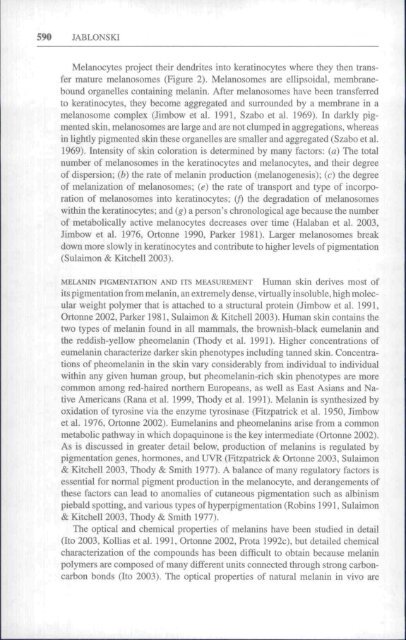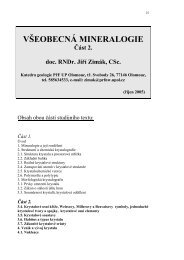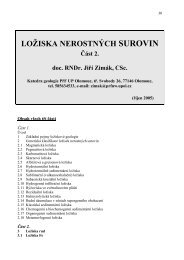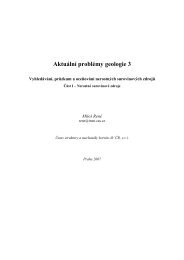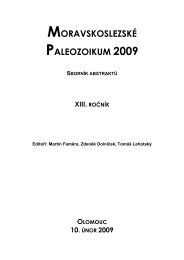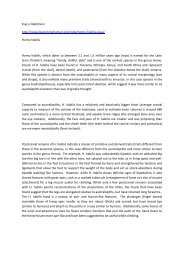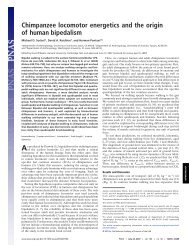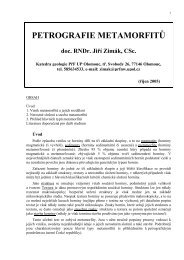THE EVOLUTION OF HUMAN SKIN AND SKIN COLOR Nina G ...
THE EVOLUTION OF HUMAN SKIN AND SKIN COLOR Nina G ...
THE EVOLUTION OF HUMAN SKIN AND SKIN COLOR Nina G ...
Create successful ePaper yourself
Turn your PDF publications into a flip-book with our unique Google optimized e-Paper software.
590 JABLONSKIMelanocytes project their dendrites into keratinocytes where they then transfermature meianosomes (Figure 2). Melanosomes are ellipsoidal, membraneboundorganelles containing melanin. After melanosomes have been transferredto keratinocytes, they become aggregated and surrounded by a membrane in amelanosome complex (Jimbow et al. 1991, Szabo et al. 1969). In darkiy pigmentedskin, melanosomes are large and are not clumped in aggregations, whereasin lightly pigmented skin these organelles are smaller and aggregated (Szabo et al.1969). Intensity of skin coloration is determined by many factors; (a) The totalnumber of melanosomes in the keratinocytes and melanocytes, and their degreeof dispersion; (b) the rate of melanin production (melanogenesis); (c) the degreeof melanization of melanosomes; (e) the rate of transport and type of incorporationof melanosomes into keratinocytes; (f) the degradation of melanosomeswithin the keratinocytes; and (g) a person's chronological age because the numberof metabolically active melanocytes decreases over time (Halaban et al. 2003,Jimbow et al. 1976. Ortonne 1990, Parker 1981). Larger melanosomes breakdown more slowly in keratinocytes and contribute to higher levels of pigmentation(Sulaimon & Kitchell 2003).MELANIN PIGMENTATION <strong>AND</strong> ITS MEASUREMENT Human skin derives most ofits pigmentation from melanin, an extremely dense, virtually insoluble, high molecularweight polymer that is attached to a structural protein (Jimbow et al. 1991,Ortonne 2002, Parker 1981, Sulaimon & Kitchell 2003). Human skin contains thetwo types of melanin found in all mammals, the brownish-black eumelaiiin andthe reddish-yellow pheomelanin (Thody et al. 1991). Higher concentrations ofeumelanin characterize darker skin phenotypes including tanned skin. Concentrationsof pheomelanin in the skin vary considerably from individual to individualwithin any given human group, but pheomelanin-rich skin phenotypes are morecommon among red-haired northem Europeans, as well as East Asians and NativeAmericans (Rana et al. 1999, Thody et al. 1991). Melanin is synthesized byoxidation of tyrosine via the enzyme tyrosinase (Fitzpatrick et al. 1950, Jimbowct al. 1976, Ortonne 2002). Eumelanins and pheomclanins arise from a commonmetabolic pathway in which dopaquinone is tbe key intermediate (Ortonne 2002).As is discussed in greater detail below, production of melanins is regulated bypigmentation genes, hormones, and UVR (Fitzpatrick & Ortorme 2003, Sulaimon& Kitchell 2003, Thody & Smith 1977). A balance of many regulatory factors isessential for normal pigment production in the melanocyte, and derangements ofthese factors can lead to anomalies of cutaneous pigmentation such as albinismpiebald spotting, and various types of hyperpigmentation (Robins 1991, Sulaimon& Kitchell 2003, Thody & Smith 1977).The optical and chemical properties of melanins have been studied in detail(Ito 2003, Kollias et al. 1991, Ortonne 2002. Prota 1992c). but detailed chemicalcharacterization of the compounds has been difficult to obtain because melaninpolymers are composed of many different units connected through strong carboncarbonbonds (Ito 2003). The optical properties of natural melanin in vivo are


